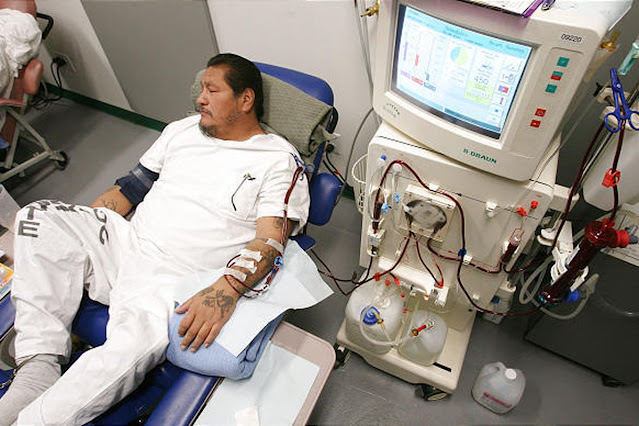WHAT IS DIALYSIS ITS WORK AND TREATMENT
Dialysis
essentially replicates renal function in patients with chronic renal failure.
Hemodialysis and peritoneal dialysis take on the critical tasks of the kidneys,
removing waste, toxins, excess salt, and fluid from the body.
Dialysis treatment does not entirely replace all kidney functions, which means that patients almost always need to take certain medications regularly. The giandliverconsultants provide the gastrointestinal consultants in Irvine. These include antihypertensive therapies, drugs to lower blood phosphates, vitamins, and drugs that increase red blood cell production to prevent anemia.
How does kidney dialysis work?
Dialyzers
for hemodialysis
A
dialyzer is an artificial filter that contains tiny fibers. The fibers are
hollow with microscopic pores in the walls, also known as a semipermeable
dialysis membrane. A special dialysis fluid flows through a filter and washes
the fibers out while blood flows through the hollow fiber to remove toxins
during hemodialysis. Due to the semi-permeability, toxins, urea, and other
small particles can pass through the membrane.
How does dialysis remove waste and toxins from the body?
The
transfer of metabolic toxins across the membrane into the dialysis fluid is
based on natural processes. This process is known as diffusion. When a
semipermeable membrane separates blood and dialysis fluid with different
molecules, the molecules move through the membrane to a lower concentration.
However, large proteins and blood cells are too large to pass through the
membrane's tiny pores, so they remain in the blood.
An
artificial membrane (dialyzer) is used in hemodialysis. In contrast, peritoneal
dialysis (the peritoneum that covers the abdominal wall).
How is excess water excreted from the body during dialysis?
Patients
with chronic renal failure usually have problems with excess fluid because they
have problems with urination.
To
remove excess water from the body during peritoneal dialysis, sugar is added to
the dialysis fluid. Because sugar molecules cannot easily pass through the peritoneal
membrane, body water passes through the peritoneum into the dialysis fluid to
balance the difference in fluid concentration. This process is known as
osmosis. By constantly injecting fresh dialysis fluid, excess water that the
kidneys cannot remove (and then accumulates in the body) can be removed from
the blood.
During
hemodialysis, if the pressure outside the hollow fiber is lower than inside,
water is removed from the body from the blood flowing through the hollow fiber.
The
process of osmosis during dialysis:
Convection
as an effective method of hemodialysis
Another
process that can be used in hemodialysis is convection. Convection plays an
essential role in haemoid filtration, a particularly effective type of
hemodialysis. During convection, water is pushed through the membrane by
hydrostatic pressure. Together with water, this pressure pulls toxins and waste
molecules across the semipermeable membrane.
Types of treatment
Hemodialysis procedure
Hemodialysis
is a treatment in which blood is filtered outside the body using a dialysis
machine. During hemodialysis, blood is drawn from a vessel and passed through a
synthetic filter called a dialyzer. In this dialyzer, the blood is purified
before returning to the body, so this dialyzer is a so-called "artificial
kidney." Hemodialysis is usually performed at least four hours three times
a week, usually in the dialysis department. An alternative to clinic-based
dialysis treatment is treatment in a familiar home environment. Different types
of home dialysis allow patients to adapt therapy to their daily routine.
However, each type of treatment has its difficulties.
You
usually need three hemodialysis sessions a week with modern dialysis machines,
lasting at least four hours. At this time, patients are connected to a dialysis
machine. This is a remarkable fact: the dialysis machine tries to achieve what
healthy kidneys do around the clock, day by day, twelve hours a week. By taking
the proper steps together, we can help you lead the healthiest life possible.
Peritoneal dialysis
Peritoneal
dialysis is so-called because blood is filtered through the peritoneum
(peritoneum) - the membrane that lines the abdominal wall during the procedure.
Dialysis fluid is stored in the cavity, and filtration occurs through the
entire plane of the peritoneum. Toxins and excess fluid are transported across
the peritoneal membrane over time - the so-called endurance time. A permanent
tube, or catheter, is inserted into the peritoneal cavity. Through it, the
dialysis fluid is fed into the cavity and left to saturate with excess
substances from the blood. After some time, the liquid is drained into an empty
bag and replaced with fresh. This process of pouring and draining is carried
out manually several times a day. It can also occur automatically at night with
a cycler (peritoneal dialysis machine).
Transplantation
Kidney
transplantation
Kidney
transplantation involves the implantation of a healthy kidney from a single
donor, living or dead, to a person with chronic kidney disease. Getting a new
kidney is not a cure for kidney disease but a treatment.
If you
want to learn more about transplantation as a treatment option, the first step
is to discuss your situation with your nephrologist. The nephrologist evaluates
your health and condition of the kidneys before making any recommendations. If
your nephrologist concludes that you will be a good candidate for a transplant,
you will probably need to be examined and tested. Your doctor can then put your
candidacy on the national transplant waiting list to get a kidney from the
deceased or find a compatible living donor.
Transplantation
is a highly personal topic - one that should be given both times and thought.
You may want to start by talking to a nephrologist about your situation. If you
both agree that transplantation is a good option, you can always be on the
waiting list if you do not have a living donor while having the opportunity to
think carefully. In addition, talking to others about the pros and cons of
transplanting can help you decide what is best for you.




Comments
Post a Comment